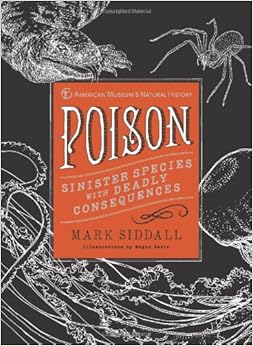 I picked up Poison - Sinister Species with Deadly Consequences by Mark Siddall from the new release shelf at my local branch of the Boston Public Library. It was a whim, but it paid off. Poison has many similarities to Amy Stewart's Wicked Bugs, including the small format and the detailed pen-and-ink scientific illustrations. The subject matter also has a good amount of overlap. Siddall, a curator for the American Natural History Museum, wrote the book in connection with an exhibit by the same name. The book was immensely readable with many fascinating vignettes, which makes me sad that I missed the exhibit (although the ANHM website suggests that it is traveling). If you want to get a sense of the style of the book, check out Siddall's piece in IFLScience.
I picked up Poison - Sinister Species with Deadly Consequences by Mark Siddall from the new release shelf at my local branch of the Boston Public Library. It was a whim, but it paid off. Poison has many similarities to Amy Stewart's Wicked Bugs, including the small format and the detailed pen-and-ink scientific illustrations. The subject matter also has a good amount of overlap. Siddall, a curator for the American Natural History Museum, wrote the book in connection with an exhibit by the same name. The book was immensely readable with many fascinating vignettes, which makes me sad that I missed the exhibit (although the ANHM website suggests that it is traveling). If you want to get a sense of the style of the book, check out Siddall's piece in IFLScience.Siddall explores a few of the many different ways that plants and animals can kill or at least send you writhing in pain. The most surprising fact of the book: platypodes are venomous! The male platypus has spurs on its hind limbs, which can deliver venom. The venom, produced only during mating season as a defense against competing males, is actually strong enough to cause mild paralysis in humans. Another incredible story concerned two vastly different organisms (pitohui birds and phyllobatid frogs) that produce the exact same toxin (batrachotoxin) despite being separated by more than 10,000 miles and millions of years of evolution. It seems that the birds and frogs both eat a particular species of flower beetle that produces this chemically unique toxin. Both species have evolved a tolerance to the poison in the beetle and can use the toxin to protect themselves from predators.
Reading the book reminded me of all the amazing things that scientists are learning about the therapeutic potential of these naturally occurring poisons. As a Scientific Editor, I read papers that examine the components of venoms from a variety of organisms. Venoms have evolved over millions of years, so they are essentially drugs designed by nature; one review article describes them as a "billion-year drug discovery program with unlimited resources" (Vetter et al., 2010). Because venoms come from such diverse species, they provide a large array of chemical and pharmacological novelty. Strikingly, venom toxins from different organisms often target common cellular pathways (e.g., ion channels, cell receptors) and use similar mechanisms to exert their effects.
 |
| Sample venomics work flow; Warrell et al., 2013 |
Tubocurarine was the first venom toxin to be used in a clinical setting; in 1942, it was introduced as a muscle relaxant. However, native South Americans were using a crude extract created from the bark of a climbing vine; the resulting curare served as an arrowhead poison for hunting animals. Similarly, the drug Captopril was developed from the active compound from pit viper venom, which was also originally used as an arrowhead poison. Because this compound can lower blood pressure, it is used to treat hypertension and heart failure.
 |
| Cone snail uses a harpoon to attack prey (from PBS.org) |
Many different venomous animals have evolved toxins that target ion channels, likely due to their conservation in many organisms. For example, sea anemone venom was the source for stichodactyla toxin, or ShK, which blocks potassium ion channels. One analog, ShK186, is currently in phase I clinical trials for the treatment of rheumatoid arthritis and multiple sclerosis. Interestingly, insects express only one type of sodium ion channel, which makes them very sensitive to ion channel inhibitors. Various species of spiders exploit this weakness by using venoms that target ion channels. Thus, these spider venoms could be sources for novel insecticides (Klint et al., 2012). Many of the ion channel inhibitors identified from venoms have also become useful tools for studying the cellular function of ion channels in the laboratory.
There are many more examples of useful therapeutics coming surprising sources. For instance, the saliva of the Gila monster was the source of Exenatide (trade name Byetta), which is used to control glucose for the treatment of type II diabetes. As screening technology and drug design methods continue to improve, scientists will be able to unlock the full economic and therapeutic potential of venom toxins.
Sources:
Review article: Venomics: a new paradigm for natural products-based drug discovery (open access)
Review article: Spider Venom peptides that target voltage-gated sodium channels: pharmacological tools and potential therapeutics leads (from a Toxicon Special Issue: Advancing in Basic and Translational Venomics)
Introduction: From venoms to drugs and Review article: From snake venom toxins to therapeutics: cardiovascular examples and (from a Toxicon Special Issue: From Venoms to Drugs)
From Venoms to Drugs - blog
The Scientist: From Toxins to Therapeutics